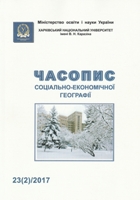Social and geographical features of transformation of industrial regions (for example Katowice conurbation, Poland)
Abstract
In connection with the intensive development of post-industrialization and globalization processes in the world, the issue of the transformation of big industrial regions is typical. The purpose of this article is to characterize the transformation processes of the Katowice conurbation in the aspect of human-geographical research. Region`s industrial development, main demographic process and the labor market, transport problems, the industrial heritage of the conurbation and the concept of the development of regional industrial tourism were characterized in this article.
The Katowice conurbation does not cope with negative demographic phenomena, in particular, the decrease in the number of inhabitants of large cities, the small number of the population of the pre-working age and the high level of emigration. The development of the conurbation`s transport infrastructure is not able to keep up with the increasing number of private car. Poor quality of public transport does not provide any alternative to the population in comparison with the capabilities of cars. Katowice conurbation`s territory has stopped being a typical industrial region. A significant part of the heavy industry and mines has been closed, and the majority of the conurbation population works in the services sector. The city and provincial governments are trying to use the remaining industrial heritage to develop regional tourism.
Downloads
References
2. Główny Urząd Statystyczny [Central Statistical Office]. Available at: http://stat.gov.pl
3. Karpiński, A., Paradysz S., Soroka P. ta in. (2015). Od uprzemysłowienia w PRL do deindustrializacji kraju [From industrialization in the PRP to the deindustrialisation of the country]. Warszawa: Muza, 396.
4. Katowice airport. Available at: https://www.katowice-airport.com/pl/lotnisko
5. Katowicka Specjalna Strefa Ekonomiczna [Katowice Special Economic Zone]. Available at: ksse.com.pl
6. Kłosowski, F. (2006) Sektor usług w gospodarce regionu tradycyjnego w warunkach transformacji i restruk-turyzacji. Przykład konurbacji katowickiej [Service sector in the traditional region's economy under conditions of transformation and restructuring. Example of the Katowice conurbation]. Katowice: Wydawnictwo Uniwersytetu Śląskiego, 255.
7. Kopalnia Guido [Guido Mine]. Available at: http://www.kopalniaguido.pl
8. Śleszyński, P. (2013). Delimitacja Miejskich Obszarów Funkcjonalnych stolic województw [Delimitation of Urban Functional Areas of voivodship capitals]. Przegląd Geograficzny, 85, 173-197.
9. Soczówka, A. (2012) Zarys historii komunikacji tramwajowej na obszarze konurbacji katowickiej [An overview of the history of tram communication in the area of the Katowice conurbation]. Acta Geographica Silesiana, 11, 57-70.
10. Sitek, S., Runge, J., Kłosowski, F., Runge, A. ets. (2013). Społeczno-gospodarcze oraz przestrzenne kierunki zmian regionalnego oraz lokalnych rynków pracy województwa śląskiego. Raport końcowy. Sosnowiec, 2013.
11. Stankiewicz, R., Stiasny, M. (2014). Atlas linii kolejowych polski 2014 [Atlas of the Polish Railways 2014]. Rybnik: Eurosprinter.
12. Tkocz, M., Soczówka, A. (2012). Industrial potential of a region as the Basic of tourism development. An example of the Silesian Voivodship (Poland). Turisiczna industria, 7, 211-216.
13. Tkocz, M. (1995). Katowice jako ośrodek regionalny w latach 1865-1995 [Katowice as a regional center in the years 1865-1995]. Katowice: Wydawnictwo «Śląsk», 156.
14. Frużyński, A. (2012). Kopalnie węgla kamiennego w Polsce [Coal mines in Poland]. Lodz: Księży Młyn, 266.
Citations
Factors of post-industrial transformations of urban sociogeosystems (case Kharkiv)
(2020) Visnyk of V.N. Karazin Kharkiv National University, series Geology. Geography. Ecology
Crossref
Copyright (c) 2017 Анджей Сочувка, Анастасия Мазурова

This work is licensed under a Creative Commons Attribution 4.0 International License.




